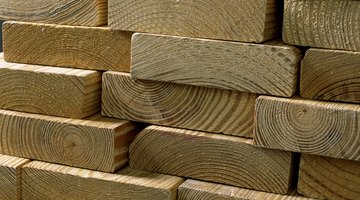The Classification of Wood
The classification of wood for lumber depends on many variables. Size, wood quality and level of pretreatment all play a part in figuring out which sort of wood is right for each construction effort.

By knowing the different ways wood can be classified, you can start to identify the correct type for whatever DIY project you are tackling.
Classification by Size
One of the first classifications of lumber is based on its dimensions. Lumber is typically cut into lengths of 2-foot multiples. The width ranges from 2 to 16 inches. As thickness changes, so does the name of the piece of lumber. A piece that is less than 2 inches thick is called a board. One that is 2 to 5 inches is called dimension lumber. Anything thicker than 5 inches is called timber.
Classification by Level of Dress
Lumber may be purchased at various levels of pretreatment known as "dressing." Rough lumber is wood that has been cut to a specific size, but has not had any extra work done, such as smoothing or making the edges perfectly uniform. Dressed lumber has been smoothed and trimmed for uniformity. Worked lumber is taken one step further than dressed lumber, and is more prepared for immediate use. An example of worked lumber is matched lumber, which is cut in such a way that the grooves of one piece can easily fit into the grooves of another.
Classification by Grade
Lumber is graded on a scale from 1 to 5. Grade 1 is lumber that is used for construction. It typically has moderately sized knots and is easily painted, making it ideal for siding and furniture making. Grade 2 is used for similar purposes, but there are more, larger knots. Grade 3 is lower-quality wood, sometimes bearing signs of splitting. This grade is typically used for non-cosmetic work, such as crates or subflooring. Grade 4 shows even more signs of defects, meaning much of the wood has to be cut away, so it is also used for jobs such as subflooring. Grade 5 is the worst quality and is typically used for throwaway projects, such as roughing out concrete pour areas.
Hardwood vs Softwood
Two different types of wood are used in lumber: hardwood and softwood. Hardwood comes from deciduous trees such as oaks and maples. Softwood comes from coniferous trees such as evergreen pines. One of the main differences between hard and soft wood is its cellular composition, with hardwoods having large, porous cells that are visible to the naked eye. Because hardwoods are so dense, they are highly durable. They are a good choice for outdoor use as well as furniture construction. Softwoods are more apt for indoor construction. Both are utilized for flooring.
References
Writer Bio
An avid lover of science and health, Meg Michelle began writing professionally about science and fitness in 2007. She holds a bachelor’s degree in physics from Creighton University and master’s degree in science writing from Johns Hopkins. Her work has appeared in publications such as EARTH Magazine.
Photo Credits
- Ingram Publishing/Ingram Publishing/Getty Images
- Ingram Publishing/Ingram Publishing/Getty Images
More Articles



